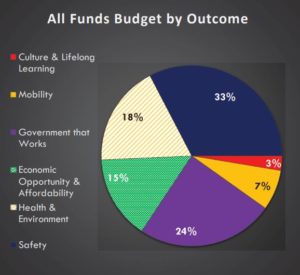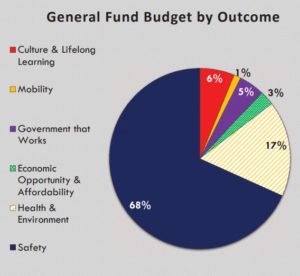Council tries ‘outcome-based’ budgeting
Friday, February 23, 2018 by
Jack Craver Last year, City Council talked about the idea of doing “outcome-based” budgeting. 2018 is the first year that it is giving it a try.
The idea is based on six strategic outcomes that Council developed last year:
- Having economic opportunities and resources that enable us to thrive in our community.
- Getting us where we want to go, when we want to get there, safely and cost-effectively.
- Being safe in our home, at work, and in our community.
- Enjoying a sustainable environment and a healthy life, physically and mentally.
- Being enriched by Austin’s unique civic, cultural, ethnic, and learning opportunities.
- Believing that city government works effectively and collaboratively for all of us – that it is equitable, ethical and innovative.
In theory, every dollar spent on every program in the budget should align with at least one of those outcomes.
“We are really making a large pivot from establishing strategic goals … into how we’re going to frame our budget discussion,” said City Manager Spencer Cronk at the beginning of a Council work session on Wednesday. “I’ll be able to hear from staff and policymakers on how we can work together to ensure that this budget is reflective of our collective priorities.”
As a result, over 2,000 distinct “budget units” within the city’s $3.9 billion operating budget have been aligned with the different outcomes. Staff is currently analyzing 10,000 units in the capital improvements budget to decide what outcomes they align with.
 Of the city’s “all funds” budget, which includes the city’s three utilities, more spending is aligned with Safety than any other outcome, due largely to the Police and Fire departments. That outcome accounts for 33 percent. The next greatest outcome – Government That Works – makes up 24 percent, followed by Health and Environment (18 percent), Economic Opportunity and Affordability (15 percent), Mobility (7 percent) and Culture and Lifelong Learning (3 percent).
Of the city’s “all funds” budget, which includes the city’s three utilities, more spending is aligned with Safety than any other outcome, due largely to the Police and Fire departments. That outcome accounts for 33 percent. The next greatest outcome – Government That Works – makes up 24 percent, followed by Health and Environment (18 percent), Economic Opportunity and Affordability (15 percent), Mobility (7 percent) and Culture and Lifelong Learning (3 percent).
Those figures are largely dependent on how staff decided to categorize spending by the utilities. Nearly the entire budget of Austin Resource Recovery, the city’s garbage and recycling service, was classified under the Health and Environment outcome. As for Austin Energy and Austin Water, staff determined that about a fifth of their budgets are geared toward Health and Environment, while most of the rest are aligned with other goals, such as Safety, Economic Opportunity and Affordability, and Government That Works.
When it comes to the General Fund, the roughly $1 billion that comes from tax revenue, Safety accounts for an even greater share: 68 percent.
 The only other outcome that earns double-digit representation is Health and Environment (17 percent), followed by Culture and Lifelong Learning (6 percent), Government That Works (5 percent), Economic Opportunity and Affordability (3 percent) and Mobility (1 percent).
The only other outcome that earns double-digit representation is Health and Environment (17 percent), followed by Culture and Lifelong Learning (6 percent), Government That Works (5 percent), Economic Opportunity and Affordability (3 percent) and Mobility (1 percent).
While Deputy Chief Financial Officer Ed Van Eenoo said that roughly 85 percent of the 2,000 units “neatly aligned with one outcome,” he conceded that there are some programs that could be categorized under multiple ones.
Interim Assistant City Manager Sara Hensley gave the example of park rangers.
“Park rangers you could look at from a safety perspective … but they also have an environmental education component, and they also provide access to parks and trails,” she said.
In cases where a program is determined to be aligned with multiple outcomes, staff will try to estimate what percentage of the spending is geared toward each. Council Member Ann Kitchen asked whether the decision is based on hard data science or more of a “gut” determination. Hensley said it was both.
“This was not an easy exercise, whatsoever,” said Hensley.
Staff is also putting an emphasis on gathering data that will give Council an idea of how effective programs are at fulfilling the strategic goals, from response times for ambulances to the number of audience members served by cultural and music programs.
The point is to force existing programs to justify their continued funding.
“Nobody on staff,” said Van Eenoo, “expects you to just dutifully rubber-stamp the budget that comes to you.”
Photo and charts courtesy of the city of Austin.
The Austin Monitor’s work is made possible by donations from the community. Though our reporting covers donors from time to time, we are careful to keep business and editorial efforts separate while maintaining transparency. A complete list of donors is available here, and our code of ethics is explained here.
You're a community leader
And we’re honored you look to us for serious, in-depth news. You know a strong community needs local and dedicated watchdog reporting. We’re here for you and that won’t change. Now will you take the powerful next step and support our nonprofit news organization?











